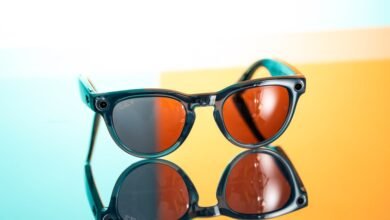Meta’s New Smart Glasses Are the Best I’ve Ever Tried

▼ Summary
– The Meta Ray-Ban Display glasses feature a discreet 600×600 pixel monocular display with 5,000 nits brightness and minimal light leakage, making it nearly invisible to others.
– They function as an extension of your smartphone, allowing hands-free access to messages, maps, photos, and apps like Instagram and WhatsApp without needing to take out your phone.
– The glasses include a Neural Band that uses electromyography for gesture control, enabling discreet operation with hand movements even when hands are hidden from view.
– Key features include live captions that identify who you’re looking at, prescription-compatible transition lenses, six-hour battery life, and upcoming handwriting recognition for messaging.
– While representing significant advancement in consumer smart glasses with practical daily applications, the product raises privacy concerns and societal implications regarding constant connectivity.
Let’s be honest, most smart glasses have felt more like clunky prototypes than practical accessories. That changes now. Meta’s new Ray-Ban Display glasses finally deliver on the long-held promise of wearable tech that blends seamlessly into daily life. After years of underwhelming attempts from various brands, these glasses stand out not just for their polish, but for how genuinely useful they are.
At first glance, they look like a slightly bold pair of Ray-Bans, chunky, stylish, and unmistakably modern. But a quick double-pinch of your middle finger brings a crisp, full-color display to life in your right eye. It’s not full augmented reality, but more like a floating menu that gives you access to messages, maps, Instagram Reels, and even live photo previews. Since the glasses pair with your phone, it’s like having a second screen that’s always within sight, yet almost invisible to everyone else.
The display itself is impressively discreet, with a 600 x 600 resolution and a 20-degree field of view. Even at a maximum brightness of 5,000 nits, light leakage is kept to a mere 2%, meaning people around you won’t see what you’re looking at. Transition lenses come standard, adjusting automatically to outdoor light. While the monocular design can feel a bit distracting at first, it doesn’t block your overall vision.
During testing, a colleague standing directly in front of me couldn’t tell I was reading a text. Stepping outside into bright sunlight, the display remained readable as the lenses darkened. That said, even 5,000 nits can’t beat direct sunlight, so maybe don’t test that particular limit.
One thing people will notice, though, is when your attention drifts. It’s subtle, but noticeable, a slight distraction in your gaze that hints you’re not fully present. It raises an interesting social question: if we already worry about phones at the dinner table, what happens when someone could be watching videos right in front of us?
Comfort is a strong suit here. The frames are thicker and more squared-off than earlier Meta Ray-Bans, with a universal-fit nose bridge that stayed put even on my lower bridge. Wide-faced users will appreciate the overextension hinges that let the arms flex outward. At just 69 grams, they’re lightweight, and battery life clocks in around six hours with mixed use. The collapsible charging case provides an additional 30 hours of power.
But the real magic happens when you pair the glasses with the Meta Neural Band. This wristband uses electromyography to read muscle signals, letting you control the display with subtle gestures, no wild arm movements required. You can pinch, swipe, and select with your hand resting casually at your side, under a table, or even behind your back.
A single pinch with your index finger selects items, while a middle-finger pinch acts as a back button. Swipe your thumb to navigate, or rotate your hand to adjust volume or zoom. It takes a minute to get used to, but soon feels surprisingly intuitive.
This combination of display and gesture control unlocks some compelling features. You can preview photos and videos before you shoot them, no more awkward angles or stray hair in the frame. Video calls through WhatsApp appear right in your vision, and the caller sees your perspective. It feels futuristic, almost like something out of a spy movie.
Messaging is another highlight. Read and reply to texts, view photos and Reels, all without touching your phone. Later this year, Meta will roll out a handwriting feature that lets you trace letters on any surface to compose messages discreetly. Predictive text helps speed things up even further.
Live captions are where these glasses truly shine. The multidirectional mic array identifies who you’re looking at and displays captions just for them, even in noisy environments. For the hard of hearing, this could be life-changing.
Navigation is another practical win. Turn-by-turn directions appear in your periphery, so you can keep your head up and stay aware of your surroundings, perfect for city walking.
Meta’s AI features also get a boost. Point the glasses at a painting, and you’ll get context and details. Ask for a recipe, and it’ll guide you step-by-step, letting you hide and recall instructions as needed.
Having tried nearly every smart glasses product out there, from Google Glass to enterprise editions and newer AR models, I can confidently say these are the first that feel ready for mainstream adoption. They’re not just technologically impressive; they’re genuinely useful.
Still, it’s impossible to ignore the bigger questions. Privacy, surveillance, and the potential for misuse linger in the background. When technology this powerful enters the wild, we have to ask what we’re gaining, and what we might be giving up.
The Meta Ray-Ban Display glasses launch on September 30th for $799, available initially in the US at retailers like Best Buy, LensCrafters, Ray-Ban Stores, and Verizon. International expansion to Canada and several European countries is planned for early 2026.
(Source: The Verge)

